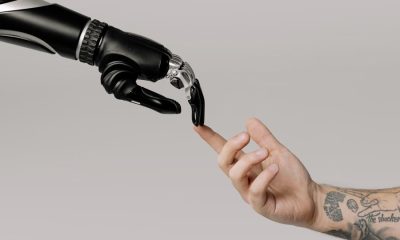Machine Learning
Nvidia Neuralangelo Can Turn 2D Videos into 3D Graphics

Nvidia’s research department recently unveiled an eye-opening new AI model that can transform dull 2D video clips into detailed 3D graphics called Neuralangelo. Nvidia Neuralangelo is based on neural networks and can successfully generate lifelike constructions, buildings, and other realistic imagery based solely on 2D videos. With this research, the company hopes to recreate virtual replicas of different structures including historical monuments, buildings, and sculptures.
Nvidia is forging a solid path through the AI industry in 2023, cementing itself as a global leader in the industry. Recently, it was announced that Nvidia’s AI-driven chipsets generates billions of dollars in gevenue for the company, and now a new AI model powered by neural networks promises advancements in architecture and 3D modeling on a level we haven’t seen since the early days of digital design.
Neuralangelo is quite obviously inspired by the famous Italian artist and sculptor Michelangelo, whose crafty hands were able to sculpt complex works of art from materials such as marble. Similarly, Nvidia Neuralangelo can generate detailed and intricate shapes and textures just based on simple 2D videos.
Nvidia Neuralangelo: 2D to 3D
Developing 3D models from scratch using traditional methods is extremely time-consuming and challenging. However, with this new AI-powered model, designers can generate structures such as “roof shingles, panes of glass and smooth marble” with impeccable details from 2D videos not only faster than traditional non-AI approaches but also more accurately than other AI-powered approaches.
All you need is a smartphone video, and Nvidia Neuralangelo will turn it into accurate renditions of your preference without sacrificing your time, money, and resources. This approach can help with landscape and architectural design, and video gaming for both corporate and personal needs.
“The 3D reconstruction capabilities Neuralangelo offers will be a huge benefit to creators, helping them recreate the real world in the digital world,” Ming-Yu Liu, senior director of research and co-author on the paper said in a statement.
He also added that developers will be able to import detailed objects into virtual environments for 3D modeling and video games starting from small objects like sculptures to massive skyscrapers.
Neural Rendering
Previously used AI models that could transform and reconstruct 3D objects had several issues including redundancy and struggling with homogenous and strong color textures. However, Nvidia Neuralangelo uses instant neural graphics primitives which helps generate intricate details and textures.
A 2D video of a scene or an object that needs to be transformed is fed into the system that selects the frames that can capture several viewpoints. This approach is similar to how different artists focus on objects they are trying to sculpt or paint from different angles.
Once the system determines the camera angle of each frame that needs transforming, Nvidia Neuralangelo transforms it into a rough 3D presentation, after which the model sharpens the details and optimises the entire 3D structure.
Neuralangelo will be presented at the Conference on Computer Vision and Pattern Recognition (CVPR) along with other Nvidia Research projects on June 18-22.
AI Security
How AI Can Improve Customer Experience in SMEs

In today’s competitive business landscape, many small and medium businesses struggle to prioritize customer experience to leverage their products and services. With AI being one of the key assets for business growth in 2023, there are many ways to leverage AI to improve customer experience, sales, and productivity in your company. According to a report in Forbes, 64% of business owners think that AI can improve customer relationships. In this guide, we’ll talk about how AI can assist in the development and improvement of customer experience in SMEs and how your business can utilise it.
How AI Can Improve Customer Experience: 5 Ways
How we use customer and sales data depends on AI. The AI can help us collect customer data, as well as analyze it for better marketing and business strategies. Here are 5 ways that can help you improve customer experience with the help of machine learning and AI.
Data-driven Virtual Assistants
Implementing AI-powered VAs can be extremely valuable for the overall service your business provides. It can cut costs and reduce wait times so your customers and clients have faster access to solutions to their problems.
AI VAs can be available on multiple platforms and guide your customers to the solution to their issues. In case the issue is too complex, it can be referred to the human customer service agent.
Having a virtual assistant powered by AI can be a great asset for a business that operates globally and can help address overworked customer support agents that are often overwhelmed by the volume of work.
Chatbots
Another way how AI can improve customer experience in SMEs is by implementing chatbots on your website. It is another way to make it easier on customer service personnel, especially if your business is small and struggles to provide round-the-clock support due to limited resources.
Chatbots are already not uncommon, especially with service providers and online stores. But, with advanced AI systems based on LLMS (Large Language Models), they’re now even more improved, and able to converse almost naturally.
AI-powered chatbots can help you collect emails, appointment dates, order numbers, and other repetitive data, while your human customer service can focus on more time-sensitive and complex tasks.
Use Sentiment Analysis
Sentiment analysis is a powerful tool you can use when creating a marketing strategy for your business. It enables marketing managers to develop strategies that resonate with their potential customers and clients.
Understanding customer feedback is one of the best ways how AI can improve customer experience in SMEs. By identifying behavioral patterns and trends in customer sentiment, SMEs can proactively address issues and improve customer satisfaction.
Predictive Analytics for Demand Forecasting
AI can help SME owners analyse customer behavior and demand based on their previous purchases, shopping cart contents, wish list, and browsing patterns. Analysing this behaviour can also help managers choose the right time to start sales and introduce new products and services.
Predictive analytics is also helpful in providing businesses with valuable insights, allowing them to optimise inventory management and influence demand patterns. By leveraging AI’s predictive abilities, SMEs can reduce costs, improve resource allocation and enhance customer satisfaction.
Enhanced Cybersecurity Measures
If you’re wondering how AI can improve customer experience in SMEs by improving the cybersecurity of your website and other assets, it’s simply because customers will appreciate knowing that their data is safe and confidential.
Maintaining robust cybersecurity is crucial for protecting customer data and ensuring their trust in SMEs. AI can enhance cybersecurity measures by monitoring network traffic and identifying and mitigating potential threats. AI is also successful at detecting anomalies that can hint at security and data breaches.
By leveraging AI-powered security systems, SMEs can enhance their ability to protect customer data, ensuring top-notch customer experience.
Conclusion
AI enables SMEs to deliver tailored and seamless experiences to their customers and clients. By implementing chatbots and AI-powered virtual assistants, as well as a streamlined e-commerce experience, positive customer feedback and satisfaction are guaranteed. Identifying how AI can improve customer experience in SMEs is crucial for leveling the playing field and competing with larger enterprises while creating long-lasting customer relationships and trust.
News
OpenAI May Release an Open-Source AI Model According to a Report

OpenAI and its ChatGPT generative AI model kickstarted a whole AI revolution in 2023. Every day, we see that new AI tools are making it to the light of day and showcasing great features that can make our everyday life easier and more productive. Still, the next step OpenAI allegedly plans to take may lead to even greater revolutionization of AI in the world. According to a new report, OpenAI is working on an open-source AI model that could change everything.
According to a new report published in The Information, OpenAI, the company behind the excellent ChatGPT generative AI model, is working on releasing a new language model which would be open-source.
Open-source programs have existed for years, and essentially it meant that the public would have access to the source code behind those programs. With OpenAI releasing an open-source AI model, people would get a chance to see the code behind ChatGPT and other GPT models.
Not the Only Open-Source AI Model
The reasoning behind this step, according to the report, is to fight competition. OpenAI’s AI models haven’t been available to the public since 2019, when the GPT-2 model was released, and caused a lot of concern regarding the possibility of it being used to spread propaganda and generate fake news that could lead to misinformation and panic.
One such concern was already voiced by The Guardian’s report in 2019, highlighting that the spread of fake information and propaganda could cause a new political threat.
Nevertheless, according to this report, it is believed that OpenAI is open-sourcing its new AI model due to competition with Meta, which also released an open-source AI model called LLaMa earlier this year.
The Meta’s AI model is quite sophisticated and advanced, being trained with over 65 billion parameters. Its complexity could put enough pressure on both Google and OpenAI to either open-source their models or release alternative models with their code visible to the public.
In return, to keep up with the competition, OpenAI would need to make better software and offer more features for its users. That said, the potentially new AI model won’t be a direct rival to GPT-4 and ChatGPT in particular.
Right now, ChatGPT based on GPT-3 model is available for free, while the more premium version of the program costs $20/month and runs on GPT-4 language model. That said, if OpenAI published its open-source AI model, it’ll likely offer fewer features than GPT-4 so it wouldn’t reduce the commercial value of ChatGPT Premium.
The potential release of the open-source AI model could change the way different tech companies develop their AI products, especially Google. After all, last month Google merged its two main AI divisions into one, so we can expect innovative AI products coming from all sides.
















